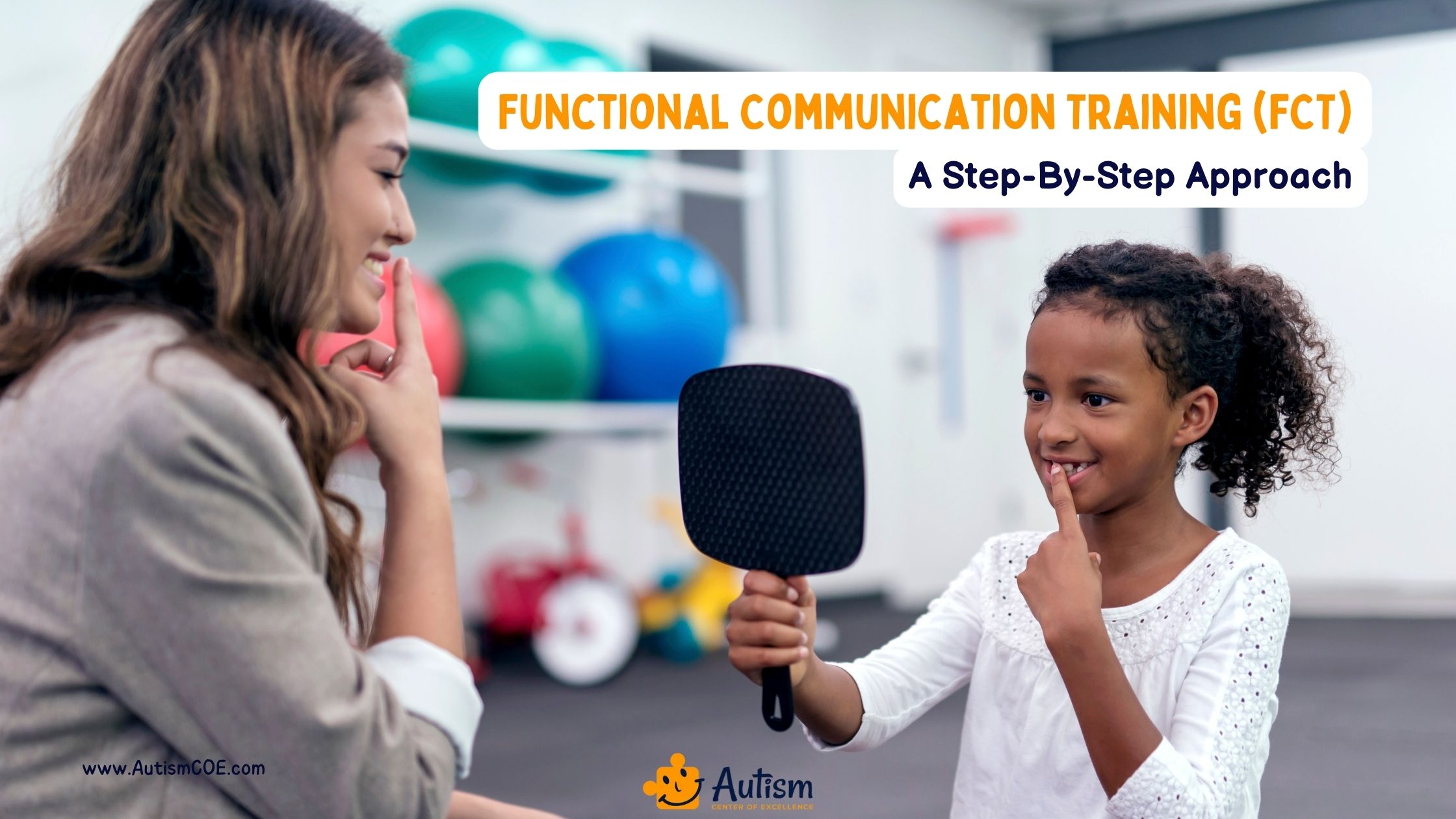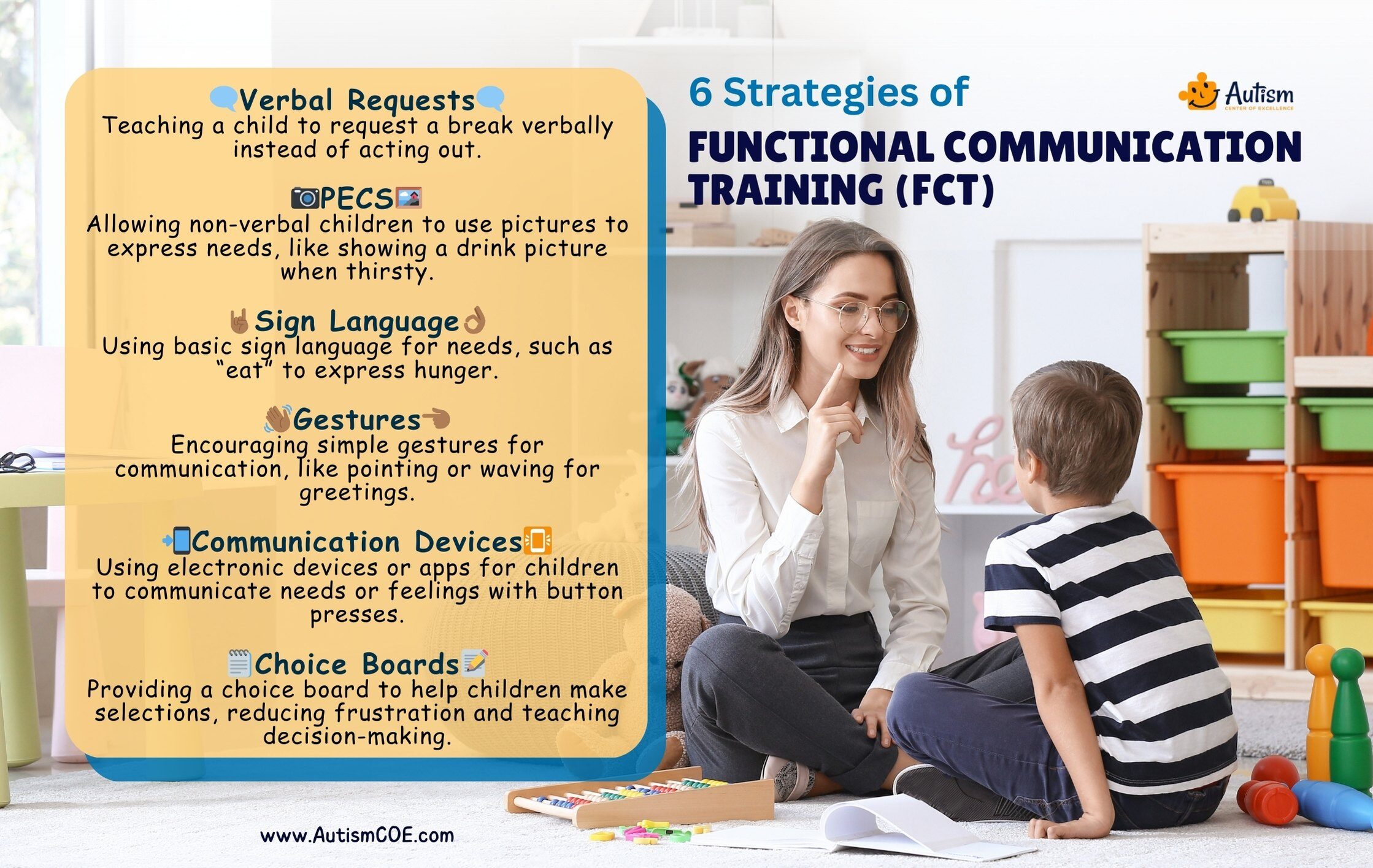Unit 29: Enhancing School Readiness Through Functional Communication Training (FCT)

School Readiness is a collaborative concern of parents, educators, and therapists, in the modern educational scene. Enhancing School Readiness for Children with Autism through Functional Communication Training (FCT) leverages Applied Behavior Analysis (ABA) to not only prepare children for academic settings but also improve vital communication skills. Acting as a strategic intervention, FCT replaces disruptive behaviors with appropriate communication, thereby fostering an inclusive learning environment.
This article will discuss FCT in ABA, its importance in School Readiness, and its effective execution, offering a great example of FCT’s involvement in promoting a child’s educational journey through descriptive examples of Functional Communication Training.
What is Functional Communication Training (FCT) in ABA?
Functional Communication Training in ABA Therapy is a therapeutic approach created to enhance communication and reduce undesirable behavior in children, particularly those with developmental disorders. FCT operates by discovering the reasons behind a child’s problematic behavior and showing them an effective way to express those needs, whether that is through words, gestures, or technology. This approach further improves their communication and social interactive skills, which forms a basis for the desired educational and social outcomes.
Which Problematic Behaviors Can Be Addressed in FCT?
FCT is one of the most successful behavioral interventions for a variety of problem behaviors, e.g. aggression, self-injury, tantrums, and noncompliance. By teaching alternative, more acceptable ways of communicating, FCT replaces these difficult behaviors with positive ways of allowing individuals to communicate their needs and wants.
When and by Whom Should FCT be Implemented?
ABA FCT should best be carried out by trained professionals such as analysts who have expertise in ABA, special education teachers, or speech-language pathologists.
It is appropriate for Autism Early Intervention Program and for individuals of any age with challenging behaviors. It is especially beneficial to start FCT in a child’s life or at the earliest sign of problematic behaviors, however, it is never too late to start. The critical point is that the person delivering FCT knows ABA principles and the particular needs of the individual receiving the training.

How to Implement Functional Communication Training (FCT)
ABA Functional Communication Training is a systematic process specially designed for the needs of each individual. Here’s a step-by-step approach:
Assessment
Commence with the Functional Behavior Assessment (FBA) which will help to recognize the particular behaviors to be targeted and learn the things that trigger them, their context, and the needs they are trying to fulfill.
Selecting Communication Responses
Select a response of communication that is suitable and functional for the person. This response is more practicable and equivalent to the troublesome behavior in addressing the individual’s needs. It might be a term, movement, expression, or utilization of an Augmentative and Alternative Communication (AAC) tool.
Developing a Teaching Plan
Develop a teaching plan that details how the communication skill will be taught. The elements of this plan should encompass the location, people participating in the training, the approaches of instruction (e.g., modeling, prompting, and fading), and the standard for correct responding.
Intervention
Execute the teaching plan in all environments and with all caregivers so that the individual can learn the new communicative response. Use the Principle of Positive Reinforcement for the purpose of strengthening the new response. Reinforcement should be timely and narrowly tied to the communication effort.
Generalization and Maintenance
After the new communication skill is mastered, generalization is the next concern, where the child should be able to use it in different places, with different kids, and in different circumstances. Ongoing maintenance activities are required to sustain the skill with time.
Monitoring Progress
Periodically assess the child’s progress and the usefulness of the FCT ABA Therapy. Modifications may be required as the individual’s needs change or if new problematic behaviors develop.
Collaboration
Empower and educate all stakeholders, including family, educators, and peers, on how to reinforce the use of the new communication skills in everyday encounters. Consistency between all parties is key for FCT to work.
Data Collection
During the FCT process, record data on the behaviors being targeted and the use of the new communication techniques. This data will determine the efficiency of the intervention and lead to further improvement.
A successful implementation of FCT is a team process that is a continuous process that requires everyone involved to be flexible and to be responsive to the changing needs of the person.
Download the Step-by-Step FCT Implementation Guide with Examples!
Also, get our weekly newsletters!
How Does FCT Address Problem Behavior in Children with Autism?
Problem Behavior in Children with Autism is addressed by Functional Communication Training (FCT) by identifying the specific needs or functions served by those behaviors, such as seeking attention or avoiding demands.
FCT provides children a better communication by teaching them socially acceptable alternatives to these needs, using words, gestures, or sign language. This method is strengthened by positive reinforcement, promoting the implementation of the newly acquired skills while preventing the behavior that is causing a problem.
What makes FCT successful is its ability to minimize children’s need to resort to challenging behaviors by providing them with the necessary responsive communication, backed up by consistent reinforcement both from caregivers and educators and across various settings.

FCT for School Readiness Program
Incorporating Functional Communication Training (FCT) into school readiness involves:
➡️ Pre-school children’s communication assessment, emphasizing skills required for classroom participation and learning.
➡️ Developing custom FCT strategies tailored to each child’s abilities, which may include:
- Picture exchange systems
- Assistive technology devices for non-verbal individuals.
- Using role plays during sessions to practice these skills
- Utilizing positive reinforcement for motivation.
➡️ Integrating FCT with education promotes learning and social skills that can be used in many different contexts.
➡️ Collaborating closely with educators and parents to offer continuous reinforcement, changing adjustments according to the child’s process and requirements.

Some Examples of FCT in ABA
Functional Communication Training (FCT) in ABA involves several practical strategies to replace challenging behaviors with appropriate communication skills. Here are some examples:
Verbal Requests
Helping a kid to say “break” instead of misbehaving when the child needs to withdraw from a demanding task.
Picture Exchange Communication System (PECS)
Enabling non-verbal children to communicate their needs through pictures for instance showing a picture of a drink when they are thirsty.
Sign Language
Teaching children some basic signs, such as “eat” to indicate hunger, can be a valuable tool for people with communication difficulties.
Gesture Use
Teaching to use simple gestures, like pointing at the object they want or waving for “hello” and “goodbye”.
Communication Devices
Communicating using electronic devices or communication apps, where the kids can push buttons that utter their needs or feelings.
Choice Boards
Offering a child a board with choices, letting the child pick their thing to do or eat hence minimizing irritation and enhancing the skill of choosing.
The FCT interventions are very personalized, they are targeted at functional replacements of problem behaviors, which represent the same function for the child, but in a socially appropriate manner.
Join Our Weekly Newsletters!
Subscribe now to stay updated with our latest email updates.
Benefits of Functional Communication Training
Functional Communication Training (FCT) is one of the most efficient ways of helping children who suffer from communication problems to communicate correctly. It has a wide use in the area of special education especially with children who have developmental disabilities or Language Disorders.
Some of the key benefits of implementing FCT include:
Reduces Problem Behaviors: By providing other means of communication, challenging behaviors are reduced by FCT.
Enhances Communication Skills: Facilitates the creation of verbal and non-verbal communication skills.
Increases Independence: Enables the children to express their own needs, enhancing self-efficacy.
Improves Social Interactions: Leads to positive peer relationships and social interaction by teaching the correct methods of communication.
Facilitates Inclusion: Improves the adaptability of communications allowing for participation in a broader variety of activities and environments.
Boosts Overall Well-being: Improvement of communication may result in higher satisfaction and quality of life for children with communication difficulties.
Frequently Asked Questions & Answer
Is Functional Communication Training an Antecedent Intervention?
Yes, FCT is viewed as an antecedent intervention because it is the teaching and reinforcing of an alternative communication approach before the problem behaviors develop.
What is the Goal of Functional Communication Training?
The main goal of FCT is to educate children on what could be done to express their needs and wants in a more appropriate and effective way so that incidents of maladaptive behavior are minimized.
What is the Difference Between DRA and FCT?
Differential Reinforcement of Alternative behavior (DRA) focuses on reinforcing any alternative behavior to the problem behavior, while Functional Communication Training is centered on teaching and reinforcing communication as the alternative behavior.
Is FCT a Replacement Behavior?
Correct, Functional Communication Training is designed to develop socially acceptable substitute behavior for challenging behaviors by teaching functional communication skills.
Conclusion
In conclusion, ABA Functional Communication Training (FCT) stands as a vital component in the toolkit of strategies employed by AutismCOE to support individuals with autism in overcoming communication barriers. In addition to reducing challenging behaviors, FCT also improves quality of life by substituting alternative, acceptable ways to express needs and desires.
By developing better communicative abilities, self-reliance, and social interactions, and by Enhancing Communication Skills, our services make it possible for Children with Autism to be better integrated with their communities and live more satisfying lives.
FCT benefits emphasize the necessity of individualized evidence-based interventions in autism support and education, revealing the critical role of focused communication strategies in the attainment of success.
Please Note: The content of this blog is for informational purposes only and should not be considered a substitute for professional medical advice, diagnosis, or treatment. Consult a qualified healthcare professional for personalized guidance tailored to your specific situation.

Bhavika Bhasin
Bhavika Bhasin is the Research and Marketing officer at AutismCOE. She works with children and adults with ASD. Her clinical research includes evaluating various available autism screening and diagnosis methods and their efficacy. She is currently developing a novel screening exam that is indicated to be more accurate than the existing available exams. She is also writes articles papers for various publications.

